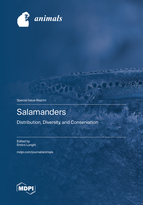Salamanders: Distribution, Diversity, and Conservation
A special issue of Animals (ISSN 2076-2615). This special issue belongs to the section "Herpetology".
Deadline for manuscript submissions: closed (31 December 2023) | Viewed by 30364
Special Issue Editor
Interests: herpetology; cave biology; ecology; evolution; conservation
Special Issues, Collections and Topics in MDPI journals
Special Issue Information
Dear Colleagues,
I am pleased to announce the opening of this Special Issue focused on urodeles! The aim of this Special Issue is to gather a wide collection of studies focused on multiple aspects of salamanders, from life history traits to conservation assessments, encompassing the wide variability in their distribution, ecology, behavior, and multiple phenotypic traits. Studies focused on the molecular biology of salamanders are also welcome. I strongly encourage the submission of studies that consider population monitoring and assessments, especially if accompanied by detailed descriptions of the adopted methodologies.
Some of the goals that the Special Issue “Salamanders: Distribution, Diversity, and Conservation” aims to reach are:
- Improving the knowledge on poorly known species;
- Providing useful methodologies and data to properly assess the species conservation status; and
- Highlighting the importance of salamanders as model species in ecological and evolutionary studies.
Dr. Enrico Lunghi
Guest Editor
Manuscript Submission Information
Manuscripts should be submitted online at www.mdpi.com by registering and logging in to this website. Once you are registered, click here to go to the submission form. Manuscripts can be submitted until the deadline. All submissions that pass pre-check are peer-reviewed. Accepted papers will be published continuously in the journal (as soon as accepted) and will be listed together on the special issue website. Research articles, review articles as well as short communications are invited. For planned papers, a title and short abstract (about 100 words) can be sent to the Editorial Office for announcement on this website.
Submitted manuscripts should not have been published previously, nor be under consideration for publication elsewhere (except conference proceedings papers). All manuscripts are thoroughly refereed through a single-blind peer-review process. A guide for authors and other relevant information for submission of manuscripts is available on the Instructions for Authors page. Animals is an international peer-reviewed open access semimonthly journal published by MDPI.
Please visit the Instructions for Authors page before submitting a manuscript. The Article Processing Charge (APC) for publication in this open access journal is 2400 CHF (Swiss Francs). Submitted papers should be well formatted and use good English. Authors may use MDPI's English editing service prior to publication or during author revisions.
Keywords
- plethodontidae
- newts
- urodela
- amphibians
- endangered species
- behavior
- phenotype
- endemism
- terrestrial
- aquatic







